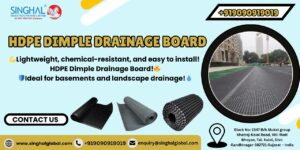Long-term performance and durability are critical factors in constructing ponds and water features. Whether a project is a koi pond, natural swimming pool, or an ornamental garden feature, the liner material will determine whether the pond functions well over time and look nice. The key points will come in much higher increases in durability, performance, and sustainability for pond liner products. The material is being recognized for far superior quality compared to traditional pond liner options including PVC and EPDM. What makes RPE pond liners so special and what’s reshaping the landscape of water feature construction?
Evolution of Pond Liners
Historically, liner materials have been so diversified as to have different merits and demerits. Ancient liners were made from materials like rubber and polyvinyl chloride (PVC). Both have proved to offer excellent resistance to water. However, these materials soon proved inadequate for enduring situations in UV resistance, puncture resistance, and lifespan considerations.
More resilient and flexible, EPDM (ethylene propylene diene monomer) rubber liners were introduced in the middle of the 20th century, especially for the pond building. EPDM is known to resist extreme temperatures, UV degradation, and can still bend around any of the possibly irregular shapes of a pond. It, however, still presented weaknesses with respect to puncture resistance and thus becomes brittle after some period, especially under harsh conditions like freezing or exposure to direct sunlight.
Meanwhile, the PVC liners were popular as a cheap and easy product for installation. But they were not so resistant to UV rays or so durable, hence liable to shorter service life, and thus there was always a pressure for developing a material that had the best attributes of these previous technologies but together with a corrective view of the shortcomings.
And here comes Reinforced Polyethylene (RPE)
What Is RPE?
RPE is a multi-layer synthetic material which integrates into its fabric the strength of polyethylene combined with layers to make it strong. It is flexible, UV-resistant, and puncture-resistant and highly durable, making it the best option for pond lining. Its construction has woven fabric sandwiched between two layers of polyethylene in order to provide great strength and resistance to punctures. It is going to be lightweight but equally very strong, a strength that will enable it to wear its harsh conditions without deteriorating or breaking.
Major Advantages of RPE Pond Liners
-Extreme Resilience
The most obvious reason why RPE pond liner in India become very popular nowadays is its extreme resilience: Traditional liners degrade upon receiving UV rays, but RPE is built with these sun rays in mind. Its extraordinary resistance to UV ensures that the liner maintains its structure for a long time even in areas exposed to intense sunlight. RPE is also resistant to punctures, tears, and abrasions, and thus it suits rough terrain and sharp objects like rocks, tree roots. In fact, RPE liners outlast the traditional EPDM liners by up to 40% and far surpass PVC liners in overall lifetime. This naturally indicates less maintenance work over time and a lower need for replacement: long-term savings for the owner of a pond.
-Stronger and More Puncture-Resistant
Reinforced polyethylene pond liners are designed to perform under the toughest conditions, such as rocky or uneven surfaces. The woven reinforcement fabric within the RPE provides added tensile strength, making it far more puncture resistant than almost any other liner. Whether the roots grow through the liner or sharp objects inadvertently enter the water, RPE is much less likely to be damaged, meaning that your pond will be safe and leak free.
-Environmental Sustainability
The other major advantage associated with RPE pond liners is the environment footprint. At the end of its lifecycle, most of the RPE liners are recycled, resulting in much less waste than an equal amount of non-recyclable vinyl ponds. In addition, RPE’s production process uses fewer resources and produces less waste and emissions, compared with average materials.
Which makes one feel that an eco-friendly water feature can, and should now, attain a sustainable pond or water garden without compromise in durability and performance. Further to that, since RPE is strongly resistant to algae growth and biofilm buildup, it maintains cleaner water that requires less aggressive chemicals to be used that might adversely affect the environment.
-Flexibility and Easy Installation
While RPE is a very hard liner, it still possesses some flexibility that makes its installation straightforward. It can thus be rolled out and even cut to whatever shape or size suited for any pond, either circular koi pond or long, weirdly-shaped natural swimming pool. It is also lighter than most other types of pond liners, therefore easier to handle and install, even by DIY enthusiasts.
With RPE, flexibility ensures not to crack or tear from movement in the ground. This is a problem that can occur with rigid liners. The combination of durability and flexibility ensures a lower occurrence of problems from ground shift or settling.
-Cost-Effective
While liners in Reinforced polyethylene pond liners are more expensive at first, compared to PVC and even EPDM types, they serve a far greater value in the long run. With longer durations and lesser needs for maintenance, it would incur less cost on one’s part and likewise less chance of requiring repairs. Labor and disposal costs for possible replacements can also be significantly reduced due to a lesser need for it.
Even more obvious are the cost savings for larger projects. One long-lasting liner will save you from costly repairs or the eventual replacement that adds up over time with more traditional materials.
-Temperature Resistance
RPE pond liner in India performs excellent at both extreme cold and extreme hot conditions. It is resistant to extreme temperature changes and does not break or crack when exposed to such situations, thus best suited for areas with very hard winters or extremely hot climatic conditions. Unlike EPDM which loses its elasticity in very cold temperatures, RPE always stays flexible and elastic regardless of the different conditions.
Use of RPE Pond Liners
RPE pond liners can be used for many applications of water features. Applications include the following:
-Koi Ponds: Koi ponds do have special needs as far as water quality goes because fish have to grow healthily under stable conditions. The durability of RPE will ensure koi ponds leak-proof with a safe environment for the fish. RPE pond liner price at Singhal Industries are very cheaper in comparison of other manufacturer.
-Swimming Pools: Natural swimming pools are those that support their filtration and biological processes. The strength of RPE for swimming pools is in the liner’s resistance to puncture and UV protection-a necessity for the pool to stand over the course of time.
-Water Gardens: For garden enthusiasts, RPE liners provide long-lasting, eco-friendly options for building beautiful water features that can adorn even the most beautiful gardens.
Large projects can be taken up by municipalities or private landowners with very large water bodies, like lakes or wetlands or reservoirs. They are perfect for low-cost and long-lasting containment.
Conclusion
RPE pond ensures durability, puncture resistance, UV stability, and flexibility-all those qualities that make it much better than traditional pond liners. The product is fast becoming the preferred choice for those seeking a strong, eco-friendly solution. Whether it is a simple garden pond or something more elaborates with a water feature, investment in RPE investment in quality, durability, and sustainability is assured. At such a time, more robust and environmentally friendly materials, RPE is set to redefine standards for pond liners for years to come.
Frequently Asked Questions (FAQs)
How long does RPE Pond Liner last?
One of the toughest pond liners around is the RPE. They are strong and puncture-resistant, ready for up to 40 years or more and can resist reasonable puncture by pike and other sharp objects.
Can I use RPE Pond Liner for both small and large ponds?
RPE liner can be small adequate for a garden pond or large enough for farming or industrial reservoirs. Canal lining, containment areas, and landfill cover applications also make use of RPE liners.
Does RPE Pond Liner require special care?
Pond Liners does require maintenance, just cleaning the liner itself removing the grass or unwanted material, and keeping the liner protected from the UV.
How do I install an RPE Pond Liner?
Step 1: Excavate hole to the desired shape, being cautious enough to make its sides sloping rather than vertical. .
2. Clear any sharp stones from around the pool. .
3. Run water slowly into the pool. At the same time, draw and tuck in the liner to put it in shape and make it smooth at the end.









